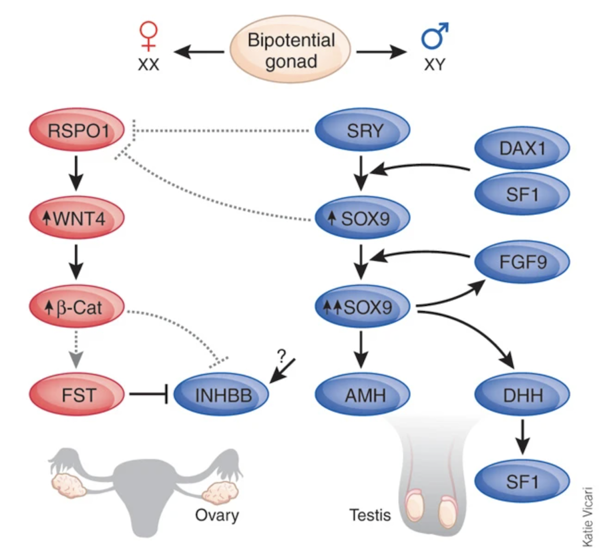
Are ‘male’ traits caused by genes on the Y chromosome or the X?
May 25, 2007

- Related Topics:
- Y chromosome,
- X linked inheritance,
- Genetic sex
A middle school student from Alabama asks:
"My dad and I want to settle something. Are baldness and other generally male traits caused by dominant genes on the Y chromosome, or recessive genes on the X chromosome?"
Excellent question! You are both right. Becoming a male is due to a dominant gene on the Y chromosome. But many of the special problems males have are because of recessive genes on the X. And there are plenty of other male-associated traits that are controlled by genes on other chromosomes as well.
Let's quickly go over what dominant and recessive are to make sure we're on the same page. Remember, we have two copies of most of our genes -- one from each parent. And these genes come in different versions, which are called alleles.
These versions can be either dominant or recessive. If you only need one copy of a gene version to get a trait, then it is dominant. If both copies need to be the same to have a certain trait, then the trait is recessive.
For example, a big part of eye color is determined by the OCA2 gene. This gene comes in two forms — brown or blue.
You only need one of your copies to be the brown kind to have brown eyes. But to have blue eyes, both copies need to be blue.
Okay, now we understand dominant and recessive. Let's now see how it applies to being male.
X and Y Chromosomes
As you probably already know, males have an X and a Y sex chromosome and females have two X chromosomes. This means a couple of things.
First, there is something about having the Y chromosome that makes a male a male. And second, males have only one copy of all of the genes on the X and Y chromosomes.
There is a gene on the Y chromosome called SRY. This gene tells a fetus to develop male body parts. It is a dominant gene.
There are rare cases where someone with two X chromosomes also has an SRY gene. These people develop as male (although with some differences from an XY male). And there are cases where someone has an X and a Y chromosome but the SRY gene doesn't work properly. These people develop as female (although with some differences from an XX female).
So becoming male is due to the dominant gene SRY. Anyone who gets one working copy of this gene looks like a male.

The other important consequence of being male is that males have only one copy of the X chromosome. This means that they only have one copy of all of the genes on that chromosome.
So what this means is that it only takes one recessive gene on the X chromosome to see a recessive trait in males. If the eye color gene were on the X chromosome, men would have blue eyes more often.
Which explains why males tend to be colorblind more often. And why they also get hemophilia, a blood clotting disorder, more often and they suffer worse from fragile X syndrome. And why they also go bald more often.
All of these traits come about because of a recessive gene on the X chromosome. Men only have one copy of these genes because they only have one X chromosome. So they suffer more often from these recessive traits than females do.
Well, this is certainly true of most of these conditions. Balding is the exception though.

Balding is not a simple trait
There does seem to be an important gene on the X chromosome that causes men to bald early in life. But it is not the only gene involved.
The kind of balding we're talking about is male-pattern hair loss (MPHL). This common type of baldness generally occurs in males. It can also occur in females but this is rare.
So how does this work exactly? Why do men get MPHL more often than women? It isn't as simple as color-blindness or hemophilia.
The scientific name for this kind of balding is androgenetic alopecia. "Andro" refers to androgens. These are hormones that our bodies produce that are associated with “maleness,” like testosterone and dihydrotestosterone (DHT). "Genetic" means that there is a gene or many genes that need to be inherited to get MPHL.
So this type of balding is the result of genes and androgens. Our bodies use androgens to turn on certain genes. To do this they need a gene on the X chromosome called the androgen receptor (AR) gene. Well, to be more precise, they need the protein the gene codes for — the androgen receptor (AR).
AR grabs testosterone or DHT, heads into the nucleus where most of our DNA is, and then turns on certain genes. We know that males who have a high level of androgen receptor protein tend to be bald.
About two years ago scientists performed a major study that has brought us closer to finding out what is going on with MPHL.1 They took several hundred balding and non-balding men and compared their androgen receptor (AR) gene.
The researchers found that the balding men were more likely to have a certain version (or allele) of the AR gene than the non-balding men. This means that one factor for determining MPHL is the X chromosome a male got from his mother. But this is unlikely to be the only factor, and there are probably many other genes that cause MPHL.
It does help explain why baldness is linked to mom's side of the family. And why men are more often bald than women.

But, as I said before, the AR gene is probably not the only gene involved. There are likely many more factors, and we can’t be sure that they are X-linked. Some will probably be on one of the non-sex-linked chromosomes, or autosomes. Each parent randomly contributes these genes to their child, so you can get them from either parent.
Actually, for a long time scientists and doctors believed that male pattern baldness was because of a dominant gene on one of these autosomes. But this study was done before we had a sequenced human genome. And many new research techniques have come about since this time.
Unfortunately, scientists are still trying to figure out the genetics behind MPHL. And it's likely not to be as simple as one gene, one trait. There could even be environmental factors that play a role. But for now, one of the best predictors we have for baldness is the version of AR gene a male gets from his mother.
So there you have it. Being male is the result of a dominant gene. But many of the problems that plague males more often are because of recessive genes on the X chromosome.

Author: Monica Rodriguez
When this answer was published in 2007, Monica was a Ph.D. candidate in the Department of Genetics, studying drosophila sex determination in Bruce Baker’s laboratory. Monica wrote this answer while participating in the Stanford at The Tech program.
 Skip Navigation
Skip Navigation
